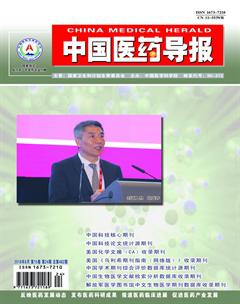单排缝合技术和缝线桥技术修补中度肩袖撕裂的比较
宗龙泽 史永涛 杨明智
[摘要] 目的 比較单排缝合技术和缝线桥技术修补中度肩袖撕裂的情况。 方法 选择延安大学附属医院2017年1~12月收治的中度肩袖撕裂患者70例,采用随机纸片法分为两组:对照组(单排缝合技术)35例,观察组(缝线桥技术)35例。观察两组患者术前、术后加州大学肩关节评分系统(UCLA)肩评分、美国肩与肘协会评分系统(ASES)评分、肩关节评分系统(constant-murley)评分、视觉模拟评分法(VAS)评分、前屈角度、外展角度、体侧外旋角度情况,比较两组临床疗效。 结果 两组患者术前、术后组间UCLA肩评分、ASES评分、constant-murley评分、VAS评分、前屈角度、外展角度、体侧外旋角度比较,差异均无统计学意义(P > 0.05)。两组患者术后UCLA肩评分、ASES评分、constant-murley评分、前屈角度、外展角度、体侧外旋角度均高于同组术前,VAS评分均低于同组术前,差异均有统计学意义(P < 0.05)。两组患者临床治疗优良率比较差异无统计学意义(P > 0.05)。 结论 单排缝合技术和缝线桥技术修补中度肩袖撕裂均具有良好的效果,二者无明显差异,值得临床推广应用。
[关键词] 单排缝合技术;缝线桥技术;中度肩袖撕裂;加州大学肩关节评分系统;美国肩与肘协会评分系统;肩关节评分系统;视觉模拟评分法
[中图分类号] R686.1 [文献标识码] A [文章编号] 1673-7210(2018)08(c)-0084-04
[Abstract] Objective To compare the conditions of single-row suture anchor technique and suture bridge suture anchor technique in repairing moderate rotator cuff tears. Methods From January to December 2017, in Yan′an University Affiliated Hospital, 70 patients with moderate rotator cuff tears were selected, they were divided into two groups by random paper method, control group (single-row suture anchor technique) had 35 cases, observation group (suture bridge suture anchor technique) had 35 cases. The shoulder score of University of California at LosAngeles (UCLA), American Shoulder and Elbow Surgeons′ Form (ASES) score, constant-murley score, visual analogue scale (VAS) score, anteflexion angle, abduction angle, body side external rotation angle of the two groups before and after operation were detected, the clinical effect of the two groups was compared. Results The UCLA shoulder score, ASES score, constant-murley score, VAS score, anteflexion angle, abduction angle, body side external rotation angle between the two groups before and after operation were compared, the differences were not statistically significant (P > 0.05). The UCLA shoulder score, ASES score, constant-murley score, anteflexion angle, abduction angle, body side external rotation angle in two groups after operation were higher than those before operation, while the VAS scores were lower than those before operation, the differences were statistically significant (P < 0.05). The excellent and good rate between the two groups had no statistically significant difference (P > 0.05). Conclusion Both single-row suture anchor technique and suture bridge suture anchor technique in repairing moderate rotator cuff tears have good effects, they have no significant difference, they are worthy of clinical promotion and application.
[Key words] Single-row suture anchor technique; Suture bridge suture anchor technique; Moderate rotator cuff tears; University of California at LosAngeles; American Shoulder and Elbow Surgeons′ Form; Constant-murley score; Visual analogue scale
肩袖撕裂在肩部各类疾病发生率中占近40%,其多发生于中老年患者,属于运动损伤,也是患者肩关节疼痛和肩关节功能丧失的重要原因[1-2]。肩袖撕裂可以分为小撕裂、中撕裂、大撕裂和巨大撕裂,本研究中纳入的患者主要是撕裂大小为1~3 cm的中度肩袖撕裂患者[3-4]。近年来随着手术技术的不断成熟和进步,治疗肩袖撕裂的手术方法也在不断发展[5-6]。单排缝合技术、双排缝合技术、缝线桥技术均是临床治疗肩袖撕裂的有效方法,但是目前关于上述手术方式疗效的报道相对较少,效果评价缺乏统一性,没有足够的数据支持。本研究选择延安大学附属医院(以下简称“我院”)关节外科收治的中度肩袖撕裂患者70例,分别采用单排缝合技术和缝线桥技术修补,探讨两种术式的临床疗效,现将结果报道如下:
1 资料与方法
1.1 一般资料
选择2017年1~12月我院收治的70例中度肩袖撕裂患者,采用随机纸片法进行分组。对照组35例,男18例,女17例;年龄40~62岁,平均(50.3±8.4)岁;肩袖撕裂大小1.5~2.7 cm,平均(2.38±0.41)cm;病程14~30个月,平均(21.7±4.5)个月。观察组35例,男16例,女19例;年龄41~61岁,平均(51.8±8.4)岁;肩袖撕裂大小1.6~2.8 cm,平均(2.32±0.48)cm;病程16~28个月,平均(20.3±4.6)个月。两组患者性别、年龄、肩袖撕裂大小、病程等一般资料比较,差异无统计学意义(P > 0.05),具有可比性。纳入标准:①术前对患者的肩关节进行MRI检查,结合临床症状确诊为中度肩袖撕裂,同时通过关节镜检查证实;②患者的肩关节疼痛和功能障碍时间>6个月,同时至少通过2个月的保守治疗没有明显的效果;③患者在术前通过MRI对肩袖撕裂尺寸测量和手术过程中获得的结果一致;④患者符合中度肩袖撕裂定义,如通过关节镜观察肩袖前后径发生撕裂和内外径撕裂范围在2~4 cm。排除标准:①既往有肩关节疾病手术史患者;②既往肩关节有骨折、脱位、感染患者;③不能参与术后随访者。本研究经医院医学伦理委员会批准,所有患者和/或家属均知情同意并签署知情同意书。
1.2 方法
1.2.1 对照组 采用单排缝合技术修补,患者给予全身麻醉,采取侧卧位,通过观察肩关节活动度,患侧肢体采用悬吊皮牵引,外展角度45°~60°。建立起后方入路,通过关节镜观察盂肱关节,然后将关节镜放置到肩峰下方间隙中,对肩峰下的滑囊进行清理,如果有必要将肩峰下缘骨赘切除,进行肩峰成形术治疗。将损伤的肩袖清理,大结节足印区去皮质化。在撕裂肩袖足印区中部放入2枚4.5 mm Healix锚钉,将撕裂肩袖缝合,打结固定。
1.2.2 观察组 采用缝线桥技术修补,在距离软骨缘5~10 mm位置放入2颗4.5 mm或者5.5 mm的带线锚钉,采用缝合钩将缝线从两端穿过肌腱,尽可能保持缝线间距相等,打结拉紧,然后将肩袖在止点处固定,给予水平褥式缝合。将2颗外排免打结挤压锚钉,放置在肱骨大结节外缘下方2 cm处,将内排锚钉的缝线交叉压入,尽可能对撕裂肩袖均匀压盖,将外排锚钉,完成整个缝线桥技术修补。
1.3 观察指标
①观察两组中度肩袖撕裂患者术前、术后加州大学肩关节评分系统(UCLA)肩评分、美国肩与肘协会评分系统(ASES)评分、肩关节评分系统(constant-murley)评分、视觉模拟评分法(VAS)评分情况。UCLA肩评分主要针对患者的肩部疼痛、功能、向前侧屈曲活动、前屈曲力量、患者满意度情况进行评分,总分35分,分数越高提示患者的肩关节状况越好[7]。ASES主要对疼痛、稳定性、功能进行评分,总分100分,分数越高提示患者肩肘功能越好[8]。constant-murley评分主要针对患者的疼痛、日常生活和手的位置、前屈、后伸、外展、内旋和肌力情况进行评分,总分100分,分数越高提示患者肩肘功能活動越好[9]。VAS以0~10 cm的标准R进行疼痛评分,0分表示无痛,10分表示剧烈疼痛[10]。两组患者治疗3个月后进行评分。②观察两组患者术前、术后前屈角度、外展角度、体侧外旋角度情况。两组患者治疗3个月后进行角度测定。③观察两组患者临床疗效。临床疗效参照UCLA评分标准分为优、良、可、差4个等级。优:34~35分;良:28~33分;可:21~27分;差:0~20分。两组患者治疗3个月后进行效果评定。
1.4 统计学方法
采用统计软件SPSS 20.0对数据进行分析,正态分布的计量资料以均数±标准差(x±s)表示,两组间比较采用t检验;计数资料以率表示,采用χ2检验。以P < 0.05为差异有统计学意义。
2 结果
2.1 两组中度肩袖撕裂患者术前、术后UCLA肩评分、ASES评分、constant-murley评分、VAS评分情况
两组患者术前、术后组间UCLA肩评分、ASES评分、constant-murley评分、VAS评分比较,差异均无统计学意义(P > 0.05)。两组患者术后UCLA肩评分、ASES评分、constant-murley评分均高于同组术前,VAS评分均低于同组术前,差异均有统计学意义(P < 0.05)。见表1。
2.2 两组中度肩袖撕裂患者术前、术后前屈角度、外展角度、体侧外旋角度比较
两组患者术前、术后组间前屈角度、外展角度、体侧外旋角度比较,差异均无统计学意义(P > 0.05)。两组患者术后前屈角度、外展角度、体侧外旋角度均高于同组术前,差异均有统计学意义(P < 0.05)。见表2。
2.3 两组中度肩袖撕裂患者临床疗效情况
两组患者临床治疗优良率比较,差异无统计学意义(P > 0.05)。见表3。
3 讨论
肩袖损伤属于肩关节比较常见的疾病,其多发生于中老年患者,其中有近20%的患者出现肩袖全层撕裂,同时随着患者年龄逐步增大,其发生率也在不断升高[11-12]。患者均会伴有不同程度的疼痛、肌力减弱、肩关节主动活动障碍、肌肉萎缩等临床症状,严重者对患者的睡眠造成影响,保守治疗和自我修复的效果十分有限,目前手术治疗是常用的方法,可以确保肩关节功能大幅度地恢复[13-14]。关节镜下肩袖撕裂的治疗方法主要包括以下几种:单排缝合技术、双排缝合技术、穿骨缝合和缝线桥技术,这些手术方法均和临床上对于解剖学位置的准确确认、结合生物力学原理有密切的关系[15-16]。缝线桥技术的宗旨是改善肩袖修补的生物力学结构,通过内排锚钉缝线,快速有效地将肩袖覆盖在足印区,均匀地释放压力,其可以承受更大的拉力负荷,并且利用足印狭小的空缺间隙[17-18]。另外缝线桥技术不需要对外排锚钉进行打结处理,这样明显缩短了手术时间,同时也减少了线结与肩峰之间的撞击[19-20]。
本研究分析我院中度肩袖撕裂患者70例,分别通过单排缝合技术和缝线桥技术进行修补,在进行两种术式评估的过程中,采用了国际上通用的UCLA评分、ASES评分、constant-murley评分、VAS评分,这些评估内容涵盖了肩袖撕裂患者的疼痛、功能、肌力和关节活动度等多方面的预后功能水平,可以更好地获得临床治疗的第一手数据,为鉴定有效的资料措施提供理论依据。两组中度肩袖撕裂患者术前、术后组间UCLA肩评分、ASES评分、constant-murley评分、VAS评分、前屈角度、外展角度、体侧外旋角度差异均无统计学意义(P > 0.05),说明两种修补技术在中度肩袖撕裂患者中均有良好的效果,并且组间差异不明显。但是有资料显示[21-23],缝线桥技术在修补大肩袖撕裂、巨大肩袖撕裂方面明显优于单排缝合技术,这有待于继续扩大样本量进一步验证。另外,本研究中均未发现肌腱的再次撕裂,可能是本研究随访时间相对较短,也可能是针对中度肩袖撕裂患者,缝合技术对于再次撕裂的影响不是特别大。另外本研究结果显示,两组患者临床治疗优良率均高于90%,且差异无统计学意义(P > 0.05),提示单排缝合技术和缝线桥技术均可以明显提高临床治疗的有效率。
综上所述,单排缝合技术和缝线桥技术修补中度肩袖撕裂均具有良好的效果,二者无明显差异,值得临床推广应用。
[参考文献]
[1] 潘海乐,张一翀,吕松岑,等.使用单排缝合技术和缝线桥技术修补中度肩袖撕裂的结果比较[J].中华肩肘外科电子杂志,2014,2(2):85-90.
[2] Collin P,Abdullah A,Kherad O,et al. Prospective evaluation of clinical and radiologic factors predicting return to activity within 6 months after arthroscopic rotator cuff repair [J]. J Shoulder Elbow Surg,2015,24(3):439-445.
[3] 裴杰,王青.肩袖撕裂双排缝合技术与缝线桥技术的疗效对比分析[J].中国运动医学杂志,2017,36(1):9-13,20.
[4] Mihata T,Watanabe C,Fukunishi K,et al. Functional and structural outcomes of single-row versus double-row versus combined double-row and suture-bridge repair for rotator cuff tears [J]. Am J Sports Med,2011,39(10):2091-2098.
[5] 田谦.关节镜下缝线桥与双排锚钉修复肩袖撕裂的疗效观察[J].现代仪器与治疗,2017,23(2):113-115.
[6] Pauly S,Fiebig D,Kieser B,et al. Biomechanical comparison of four double-row speed-bridging rotator cuff repair techniques with or without medial or lateral row enhancement [J]. Knee Surg Sports Traumatol Arthrosc,2011,19(12):2090-2097.
[7] Amstutz HC,Sew HA,Clarke IC. UCLA anatomic total shoulder arthroplasty [J]. Clin Orthop Relat Res,1981,1(155):7-20.
[8] Richards RR,An KN,Bigliani LU,et al. A standardized method for the assessment of shoulder function [J]. J Shoulder Elbow Surg,1994,3(6):347-352.
[9] Charousset C,Zaoui A,Bella?觙che L,et al. Does autologous leukocyte-platelet–rich plasma improve tendon healing in arthroscopic repair of large or massive rotator cuff tears` [J]. Arthroscopy,2014,30(4):428-435.
[10] 胡寧利,王景阳.慢性疼痛的药理学[J].国外医学:麻醉学与复苏分册,1998,19(4):219.
[11] Lee HI,Shon MS,Koh KH,et al. Clinical and radiologic results of arthroscopic biceps tenodesis with suture anchor in the setting of rotator cuff tear [J]. J Shoulder Elb Surg,2014,23(3):e53-e60.
[12] Lindley K,Jones GL. Outcomes of arthroscopic versus open rotator cuff repair:a systematic review of the literature [J]. Am J Orthop(Belle Mead NJ),2010,39(12):592-600.
[13] 刘少华,李宏,孙亚英,等.关节镜下单排与缝线桥技术修复中型肩袖撕裂——临床与核磁共振评价[J].中国运动医学杂志,2017,36(2):97-100,105.
[14] Pedowitz RA,Yamaguchi K,Ahmad CS,et al. American Academy of Orthopaedic,S. Optimizing the management of rotator cuff problems [J]. J Am Acad Orthop Surg,2011, 19(6):368-379.
[15] Hernigou P,Lachaniette CHF,Delambre J,et al. Biologic augmentation of rotator cuff repair with mesenchymal stem cells during arthroscopy improves healing and prevents further tears:a case-controlled study [J]. Int Orthop,2014,38(9):1811-1818.
[16] Hotta T,Yamashita T. Osteolysis of the inferior surface of the acromion caused by knots of the suture thread after rotator cuff repair surgery:knot impingement after rotator cuff repair [J]. J Shoulder Elbow Surg,2010,19(8):e17-e23.
[17] 李梦远,郑秋坚.关節镜下治疗肩袖撕裂的现状和研究进展[J].中华创伤骨科杂志,2014,16(4):348-350.
[18] Millett PJ,Warth RJ,Dornan GJ,et al. Clinical and structural outcomes after arthroscopic single-row versus double-row rotator cuff repair:a systematic review and meta-analysis of level Irandomized clinical trials [J]. J Shoulder Elb Surg,2014,23(4):586-597.
[19] 陈刚,潘界恩,黄成龙,等.关节镜下双排缝合桥技术治疗中大型肩袖全层撕裂[J].中华创伤杂志,2015,31(9):823-828.
[20] Castagna A,Borroni M,Garofalo R,et al. Deep partial rotator cuff tear:transtendon repair or tear completion and repair A randomized clinical trial [J]. Knee Surg Sport Tr A,2015,23(2):460-463.
[21] 谢杰,孙亚英,殷浩,等.关节镜下肩袖修补联合粘连松解术治疗肩袖撕裂合并肩关节僵硬疗效分析[J].中国运动医学杂志,2015,34(7):633-637.
[22] Hein J,Reilly JM,Chae J,et al. Retear rates after arthroscopic single- row,double- row,and suture bridge rotator cuff repair at a minimum of 1 year of imaging follow-up:a systematic review [J]. Arthroscopy,2015,31(11):2274-2281.
[23] Ji X,Bi C,Wang F,et al. Arthroscopic versus miniopen rotator cuff repair:an up-to-date meta-analysis of randomized controlled trials [J]. Arthroscopy,2015,31(1):118-124.
(收稿日期:2018-03-30 本文编辑:苏 畅)

